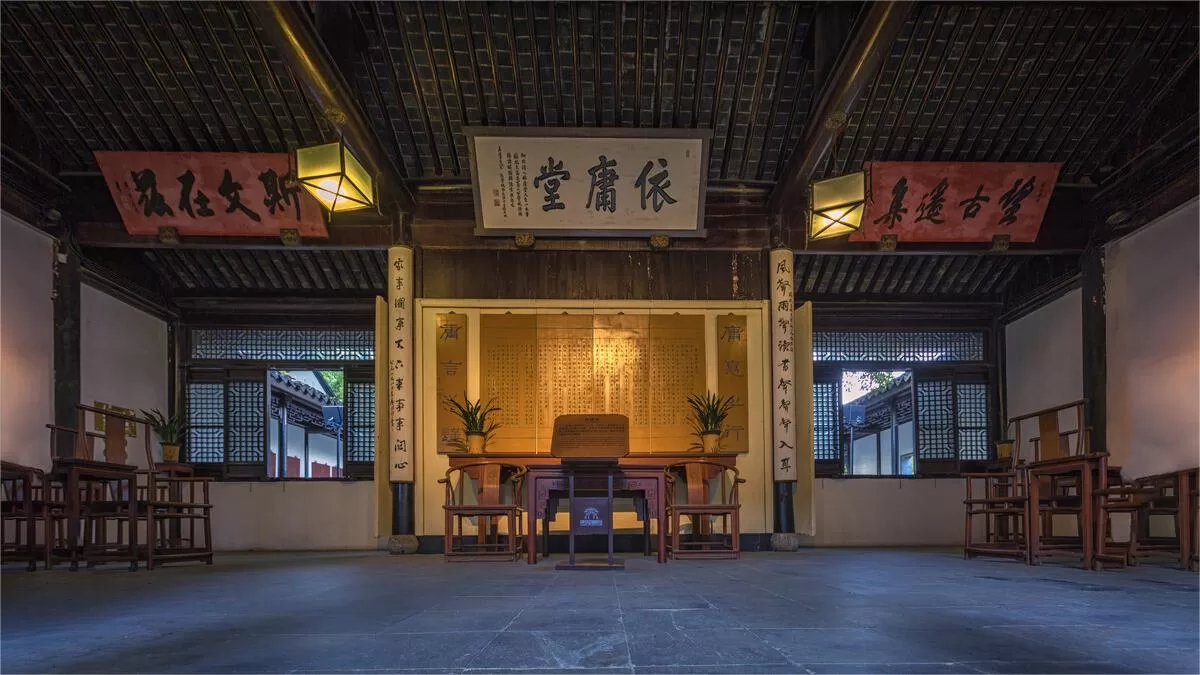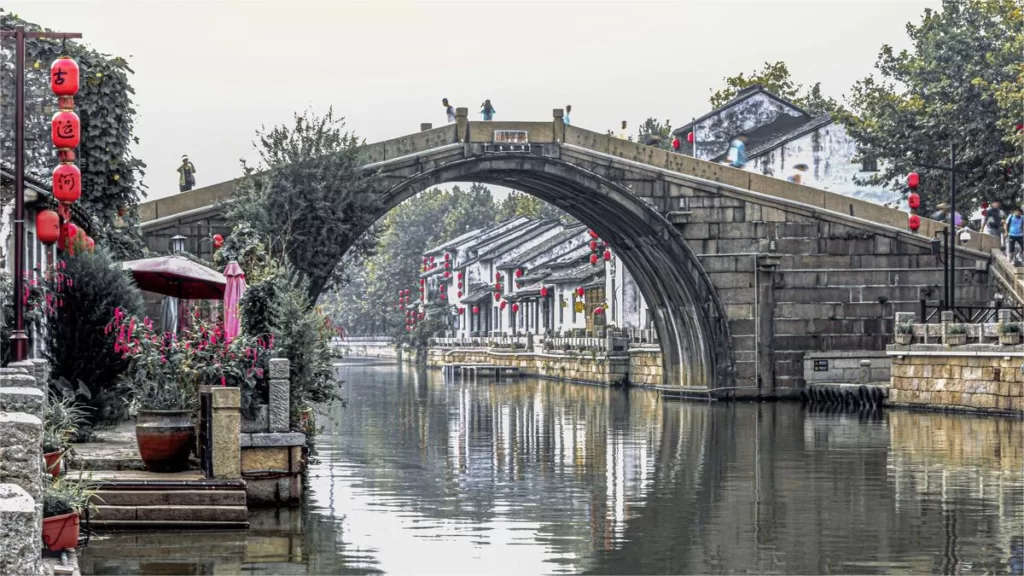Donglin Academy (东林书院) in Wuxi, founded by Yang Shi in the year 1111, has a rich history that spans centuries. It was initially established but later abandoned. However, in 1604 during the Ming Dynasty, Gu Xiancheng and others undertook the reconstruction of the academy and used it as a place for scholarly pursuits. Unfortunately, it met with an order for demolition from Wei Zhongxian.
During the Qing Dynasty, the academy was rebuilt, and it occupies an impressive area of 13,000 square meters. Donglin Academy is renowned for promoting the spirit of “reading, scholarly discourse, and patriotism.” This spirit gained widespread recognition among scholars across the nation during the late Ming Dynasty, elevating the academy’s reputation.
Donglin Academy also played a pivotal role during the political strife of the late Ming Dynasty, serving as a gathering place and origin for members of the “Donglin Faction.” It became a focal point in national politics and a prominent hub for intellectual discourse in the Jiangnan region.
One of the most prominent features of Donglin Academy is the famous couplet that hangs within its walls: “The sound of the wind, the sound of the rain, the sound of reading, all resonate in one’s ears. Family matters, national affairs, and worldly matters are all matters to be concerned about.” This couplet aptly captures the essence and significance of Donglin Academy, reflecting its dedication to knowledge, public discourse, and the well-being of both family and nation.
Table of Contents
- Basic Information
- Location and Transportation
- Highlights of Donglin Academy
- Vlog about Donglin Academy
- Useful Information Summarized from Reviews
- Attractions near Donglin Academy
Basic Information
| Estimated Length of Tour | 2 hours |
| Ticket Price | Free |
| Opening Hours | 9.00 – 17.00; Last admission: 16.30 |
| Telephone Number | 0086-0510-82706231 |
Location and Transportation
Donglin Academy is located at 867 Jiefang East Road, Liangxi District, Wuxi City, Jiangsu Province, China. To get there, you can choose the following ways:
Metro:
- Take Subway Line 2 and get off at Donglin Square Station. From there, it’s a short walk of less than 100 meters to reach Donglin Academy.
- Alternatively, you can take Subway Line 1 or Subway Line 2 and get off at Sanyang Square Station. After exiting the station, head east and walk approximately 800 meters to reach Donglin Academy.
Bus:
- Take bus routes 3, 15, 55, 57, 501, 701, 705, 712, or 767 and get off at Donglin Academy (Guangda Bank) Stop. From there, it’s a short westward walk of about 100 meters to reach the academy.
- Alternatively, you can take bus route 10 and get off at Xinsheng Road (Renmin Middle Road) Stop. After alighting, head east and walk approximately 200 meters to arrive at Donglin Academy.
Highlights of Donglin Academy
Stone Archways

The stone archways at Donglin Academy, established in 1604, stand as iconic symbols of this esteemed institution. Positioned at the entrance of the academy’s architectural complex, these archways impart an air of solemnity and antiquity to the entire structure.
In 1626, during a period of political turmoil, Donglin Academy faced destruction at the hands of the Eunuch faction, and the stone archways suffered the same fate. However, in 1740, efforts were made to restore the stone archways to their former glory.
These archways stand at an impressive height of 7.24 meters. They are adorned with exquisite carvings, including depictions of two dragons playing with a pearl, a red phoenix facing the rising sun, lions frolicking with embroidered balls, and carp leaping over the Dragon Gate, among other intricate designs.
Lize Hall

Lize Hall, established in 1604, holds a special place within Donglin Academy. Its name, coined by the leader of Donglin, Gu Xiancheng, carries a profound metaphorical meaning, signifying the exchange of knowledge and scholarly discussions among friends. Gu Xiancheng emphasized the importance of collective effort and mutual support in the pursuit of knowledge, stating that learning requires collaboration and assistance from all to succeed.
Lize Hall served as a vital hub for scholarly discourse and lectures within Donglin Academy. During its heyday, scholars and intellectuals from all over the country, would gather here for discussions. The hall was often filled with a multitude of teachers and students, creating an unprecedented atmosphere of intellectual exchange and camaraderie. It was a place where minds came together to explore ideas.
Sangong Temple

Sangong Temple, with its origins dating back to the year 1655, is a historically significant site within Donglin Academy. This temple is dedicated to the veneration of three notable figures: Ouyang Dongfeng, Zeng Ying, and Lin Zai. These three individuals played a pivotal role in protecting Donglin Academy and its scholars from persecution by the Eunuch faction during the years 1604 to 1627. Their dedication and actions garnered them the love and admiration of the local people.
Unfortunately, Sangong Temple faced destruction during the years 1851 to 1861, likely due to the turbulent times it endured. However, in 1871, efforts were made to restore and rebuild this important place of worship and remembrance.
Wancui Shanfang

Wancui Shanfang, a part of Donglin Academy, is a place of scholarly pursuits and reflection. This structure was originally built during the Qing Dynasty and underwent a restoration in 1947. It holds a special significance as one of the study rooms where scholars gathered for lectures and discussions within Donglin Academy.
The name “Wancui” typically refers to the vibrant green color of trees that persists even through the winter. Symbolically, it represents a spirit of unwavering perseverance in the face of adversity. “Shanfang,” on the other hand, traditionally refers to a house in a mountainous or secluded setting. In this context, it signifies a serene and tranquil space dedicated to reading and contemplation.
Long Corridor

The Long Corridor in Donglin Academy, first constructed during the late Ming Dynasty, serves as a significant architectural feature that connects the main buildings of the academy with the surrounding structures. Its primary purpose was to facilitate the movement of students during inclement weather, providing shelter and passage.
Today, the Long Corridor is adorned with over twenty inscriptions and stone tablets that document various renovations and repairs carried out at the academy throughout the Ming and Qing dynasties. Among these inscriptions, there are three notable items of historical and artistic significance. One is the original stone for the “Tingyun Pavilion Model Calligraphy” by the renowned Ming Dynasty calligrapher Wen Zhengming
Other Ancient Halls

In addition to the previously mentioned buildings, Donglin Academy boasts a rich collection of ancient halls and structures that contribute to its historical and cultural significance. Some of these notable structures include:
- Yiyong Hall (依庸堂): Yiyong Hall is a place dedicated to hosting various ceremonies and rituals within Donglin Academy. It serves as a central gathering point for important academic and ceremonial events.
- Yanju Temple (燕居庙): Yanju Temple is a place of reverence where Confucius is honored. It is a site for paying respects to the great philosopher and educator, and it plays a role in promoting Confucian values and teachings within the academy.
- Xinle Pavilion (寻乐亭): Xinle Pavilion is a pavilion or gazebo where one can enjoy the surrounding natural scenery and find moments of leisure and relaxation. It offers a peaceful environment for scholars and visitors to appreciate the beauty of the academy’s surroundings.
Vlog about Donglin Academy
Useful Information Summarized from Reviews
Cafes and Tea Houses Inside the Academy: Donglin Academy hosts cafes and tea houses, providing a perfect setting for afternoon tea with friends.
Spirit of Donglin Academy: Donglin Academy promotes the spirit of “reading, lecturing, and patriotism.” In the late Ming Dynasty, this spirit gained widespread recognition among scholars nationwide, elevating the academy’s reputation. The academy served as a gathering place and origin for members of the “Donglin Party” during the political conflicts at the end of the Ming Dynasty.
Beautiful Garden at the Back:The garden at the back of the academy is known for its beauty. The ducks in the pond add to the serene atmosphere, and they are well-kept.









Coming out of exit 1 of Line 2 subway, you will find Donglin Academy. It is like an open and free park, with themed activities and corresponding shops related to the lives of scholars in the academy. The main focus is on the history and important figures of Donglin Academy.